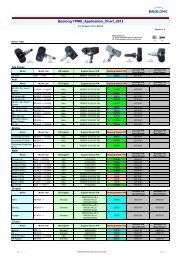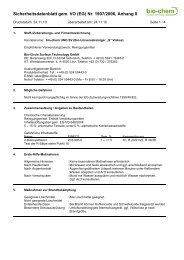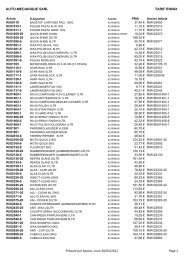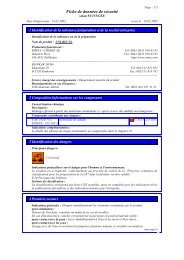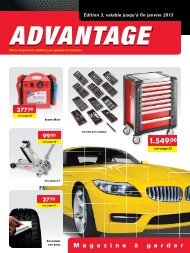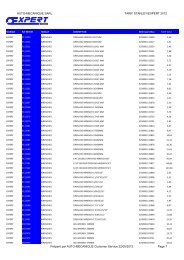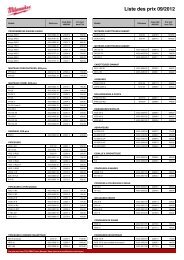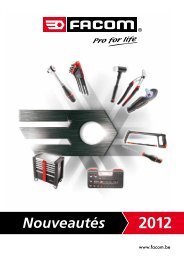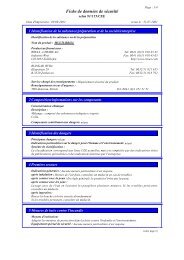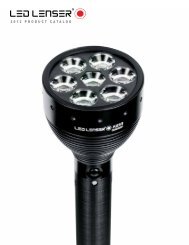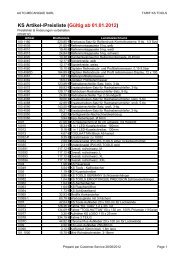REPAIR & SUPPLIES - Auto-Mecanique
REPAIR & SUPPLIES - Auto-Mecanique
REPAIR & SUPPLIES - Auto-Mecanique
Create successful ePaper yourself
Turn your PDF publications into a flip-book with our unique Google optimized e-Paper software.
Relearn – Many TPMS systems require retraining<br />
each time the tires/wheel are rotated or a sensor<br />
is replaced. Retraining is necessary for the system<br />
to learn the sensor(s) new postion(s). A relearn<br />
procedure may need to be followed in order to retrain<br />
the system. Relearn procedures differ by vehicle<br />
makes and are sometimes found in the vehicles<br />
Owner’s Manual. In those instances where the relearn<br />
procedure is not found in the Owner’s Manual a TPMS<br />
service guide may need to be referenced to find the<br />
relearn procedure.<br />
RF – Radio Frequency (Transmitted Frequency)<br />
Service Kit – Kit of components needed to properly<br />
service TPMS sensors. This kit can include replacement<br />
valves, cores, caps, grommets, locking nuts,<br />
and washers. The OEM recommends replacing the<br />
EPDM grommet, valve cap, valve core and locking nut<br />
every time a TPMS sensor is removed from the wheel<br />
or the wheel is serviced.<br />
Ship Mode – Also referred to as Off Mode is the<br />
TPMS sensor state where no transmission occurs and<br />
pressure sampling occurs once every 30 seconds.<br />
Mainly used for shipment and storage, sensors will<br />
remain in this condition until activated into another<br />
mode. Sensors being shipped from overseas are often<br />
shipped in Off Mode because the FCC will not allow<br />
any electronic devices to transmit any type of signal<br />
that may interfere with radio air waves. It is important<br />
to note that not all sensors are shipped in this mode.<br />
Sleep Mode – TPMS sensor state that occurs in<br />
between the time the sensor transmits and<br />
measures data.<br />
Snap-In Style Sensor – Sensor mounted to the<br />
wheel through the rim hole using a special rubber<br />
snap-in valve that is attached to the sensor module<br />
using a special T-10 TORX head screw. To identify a<br />
Snap-in TPMS sensor, look for a long valve cap or an<br />
extended brass shoulder.<br />
Test Mode – Sometimes referred to as Factory Test<br />
Mode, is the state in which the sensor transmits at<br />
the most frequent transmission rate possible. This<br />
mode is used by vehicle assembly plant tests.<br />
TPM – Tire Pressure Monitoring.<br />
TPMS Sensor – Also referred to as sensors, are<br />
wheel based electronic sensors used to transmit<br />
information/data in TPMS systems.<br />
TPMS – Tire Pressure Monitoring System. A<br />
warning system that notifies the driver when a<br />
tire is significantly under-inflated.<br />
TPMS Grommet – Many stem mounted sensors<br />
use a special rubber grommet for sealing. The OEM<br />
recommends replacing the grommet whenever the<br />
sensor is removed from the wheel. The rubber<br />
grommet provides the air seal in the valve stem<br />
opening, and a new one should be used to ensure<br />
a fresh seal after each service.<br />
TPMS Nut – Many TPMS sensors are attached to the<br />
wheel using a specially designed sealing nut. The<br />
OEM recommends replacing these nuts whenever it<br />
is removed. These nuts are either 11mm or 12mm.<br />
Each manufacture has its own recommended torque<br />
specification for the TPMS nuts.<br />
TPMS Valve Cap – TPMS sensors with an aluminum<br />
valve stem require a specially designed sealing cap.<br />
Sensors with an aluminum stem cannot use a<br />
standard (non-TPMS) valve cap. These special valve<br />
caps are designed for use with TPMS sensors and<br />
protect against the corrosion that forms when<br />
dissimilar metals come in contact.<br />
TPMS Valve Core – Many TPMS sensors have an<br />
aluminum valve stem with a specially designed valve<br />
core. The OEM recommends replacing this valve core<br />
whenever it is removed. Sensors with an aluminum<br />
valve stem cannot use a standard brass valve core;<br />
instead, they require a special nickel-plated valve<br />
core to protect against the corrosion that forms when<br />
dissimilar metals come in contact. The Tire and Rim<br />
Association (TRA) recommends a torque specification<br />
of 2 – 5 inch pounds for TR C1 valve cores. Sensors<br />
with a rubber valve stem may use a standard brass<br />
valve core for replacement.<br />
TRA – Tire and Rim Association. The standardizing<br />
body for the tire, rim, valve and allied parts industry<br />
for the United States.<br />
TREAD Act – Transportation Recall Enforcement<br />
Accountability Documentation Act. The law that<br />
mandates, beginning September 1, 2007, all new<br />
vehicles sold in the U.S. under a GVW of 10,000 lbs.,<br />
excluding motorcycles and light duty trucks with dual<br />
wheels on an axle, are required to be equipped with<br />
a tire pressure monitoring system (TPMS) to warn<br />
drivers when one or more of a vehicles tires are<br />
under-inflated by 25% or more.<br />
TSS – Tire Safety System<br />
UHF – Ultra High Frequency 315MHz and 433.92<br />
(sometimes referred to as 434) MHz.<br />
Keeping You On the Road 117



